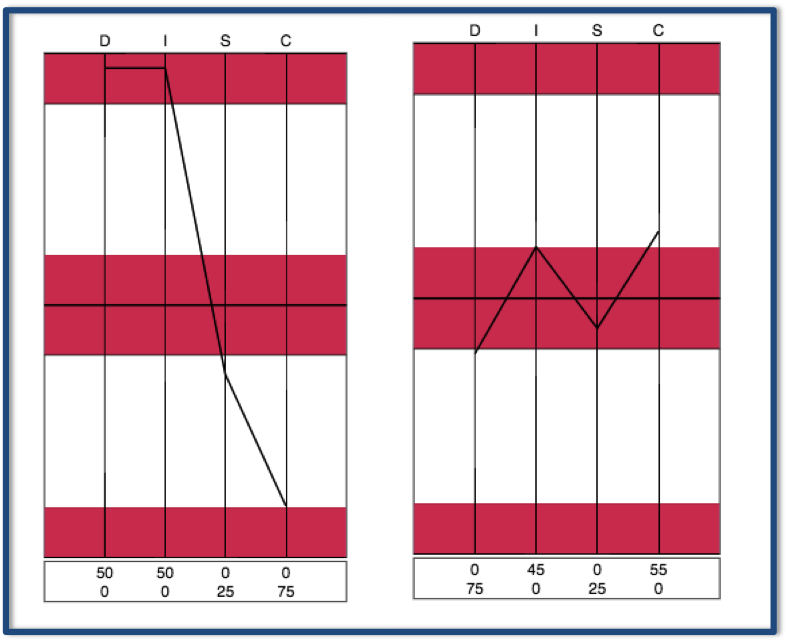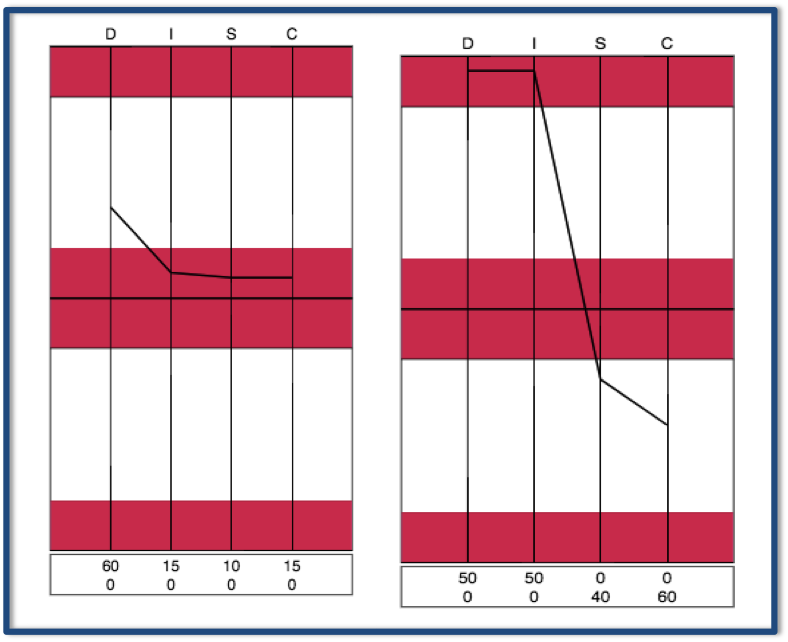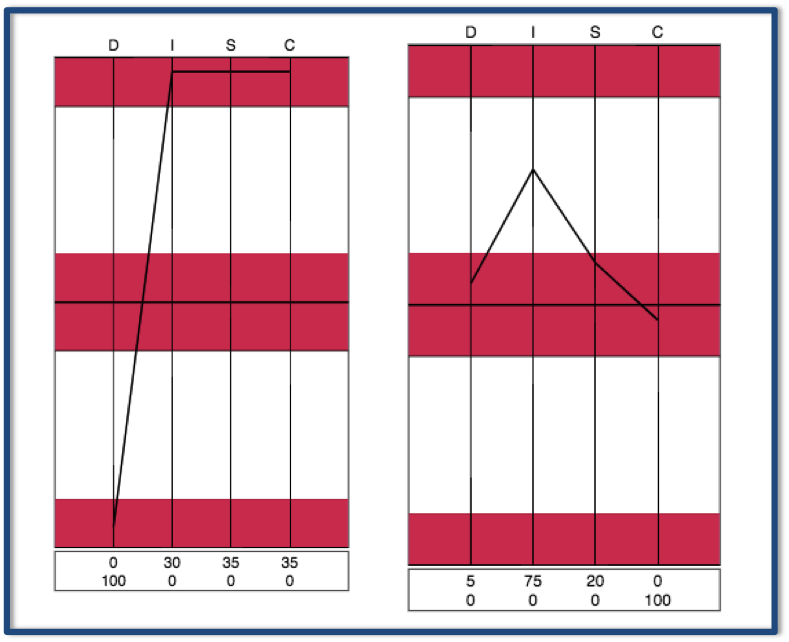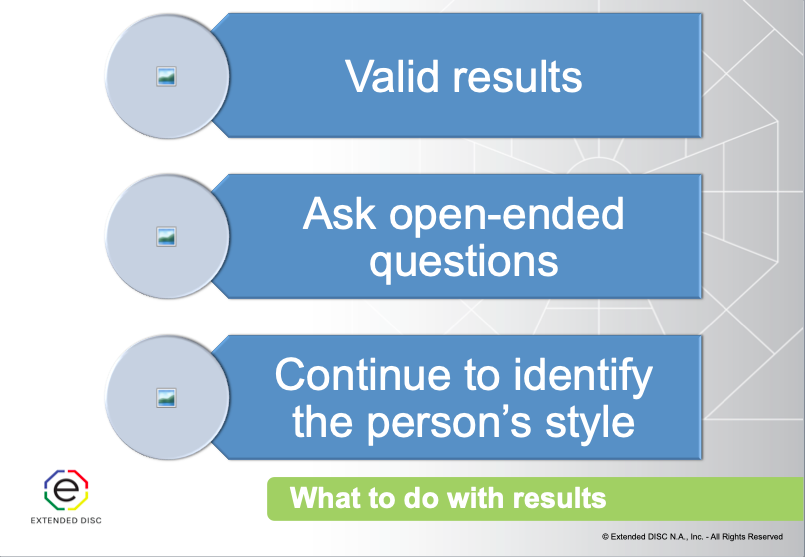You can identify key emotions to help provide deeper insight into a person’s Extended DISC® Profile results.
Key emotions overview
 The ability to identify key emotions in a person’s profile result is unique to Extended DISC® tools. Underlying emotions are identified by observing the person’s profile size, shape, and position. Do not assume that these underlying feelings are automatically occuring or even occurring right now. We should consider these types of results as an additional way to provide clues to topics that could be explored or discussed further. They can help provide answers to the question, ‘how is the person feeling?’
The ability to identify key emotions in a person’s profile result is unique to Extended DISC® tools. Underlying emotions are identified by observing the person’s profile size, shape, and position. Do not assume that these underlying feelings are automatically occuring or even occurring right now. We should consider these types of results as an additional way to provide clues to topics that could be explored or discussed further. They can help provide answers to the question, ‘how is the person feeling?’
DISC workshops are usually not the best place to dive deeper into individual results or discuss key emotions. However, if you are coaching or mentoring someone one-on-one, it can provide additional information on what the person may be feeling. In doing so, it can help identify what may be an obstacle to the person’s success. There is nothing in the person’s report that will talk about the person’s key emotions. The ultimate goal is not to memorize, but to recognize when these special situations profiles may occur. Here are some examples of Extended DISC® Profiles that may exhibit key emotions.
Tight Profiles: Profile I
 A tight profile is identified if either Profile I or Profile II is entirely – or almost entirely – located within the neutral (shaded) zone around the Middle Line. A tight or compressed profile is created as a result of the pattern in which the person answered the Extended DISC® Questionnaire. The pattern identifies a less consistent pattern of answering.
A tight profile is identified if either Profile I or Profile II is entirely – or almost entirely – located within the neutral (shaded) zone around the Middle Line. A tight or compressed profile is created as a result of the pattern in which the person answered the Extended DISC® Questionnaire. The pattern identifies a less consistent pattern of answering.
The example above represent a person’s Profile I (Perceived Need to Adjust) and Profile II (Natural Style). D-style and I-style are above the Middle Line in both profiles; however, the size and the shape of the two profiles are clearly different. All four styles on Profile I (above image on left) are plotted close to the Middle Line or essentially plotted in the shaded Neutral Zone. Profile II (above image on right) has a wide size and shape with a clear gap between the D and I styles above the Middle Line (natural styles) over the S and C styles below the Middle Line (not natural styles).
The key feeling associated with a tight Profile I is uncertainty. They may not have been able to form a clear understanding of their role in their present work environment. This could be caused by unclear job responsibilities, being new to a position or role, or they’re seeking change to their existing situation. The person may not be certain how to modify their behavior. We are more likely to expect this result if the person is new to their job. If someone is not new, then it could mean something else is going on, and we need to explore deeper. If several team members show similar tight Profile I results then it would be beneficial to look at the team’s leader and how clearly they are defining team goals.
Tight Profiles: Profile II
 If Profile II – Natural Style (above image on right) is tight, the person may be feeling a sense of pressure. Our first assumption is they could just be having a bad day where they were unable to focus. However, the person could also be feeling their future is not secure or perceive a threat that pertains to something they perceive as valuable. The feeling may be tied to the person’s personal life or intertwined between work and personal (e.g., financial issues). For example, they may be feeling a threat of losing their job, hear rumors about organizational changes, or be experiencing personal problems.
If Profile II – Natural Style (above image on right) is tight, the person may be feeling a sense of pressure. Our first assumption is they could just be having a bad day where they were unable to focus. However, the person could also be feeling their future is not secure or perceive a threat that pertains to something they perceive as valuable. The feeling may be tied to the person’s personal life or intertwined between work and personal (e.g., financial issues). For example, they may be feeling a threat of losing their job, hear rumors about organizational changes, or be experiencing personal problems.
Tight profiles are still considered valid results, however the tighter that Profile II becomes, the more careful you need to be with the interpretation. If Profile II becomes too tight (entirely within the neutral zone) it may end up creating an invalid result.
Shifting Profiles: Overshift Profile I

The Profile II – Natural Style (above image on right) identifies D and I styles above the Middle Line. The graph line has the nice wide shape that does not suggest any underlying emotions.
On the other hand, the Profile I (above image on left) has all 4 styles plotted above the Middle Line. This type of Profile I is identified as an overshift profile and the key emotion tied to it is ‘helplessness.’ This type of Profile I could indicate the person feels constrained or feels they are acting at the limits of their abilities. They may be feeling forced to go completely against their natural behavioral style in order to succeed in the demands of their present environment. This person may feel the need to be everything to everyone or overwhelmed in their present setting. They may be feeling helpless because they are identifying the need to be all styles; a situation that no amount of energy can sustain.
Shifting Profiles: Ascending Profile II

Profile II (above image on right) reflects the core of who we are deep down and is more internalized. The shifting of a profile is the overall movement of the entire profile in relation to the Middle Line. The shifting upward of the profile is called an ascending profile.
An ascending Profile II likely identifies the person’s underlying feeling as pressure.The person is more likely to feel a fundamental challenge they need to overcome. They may feel the pressures of the environment are too much to handle. The consequences of failure are more fundamental and internalized versus an ascending Profile I. For example, a person with an ascending Profile II could be feeling overwhelmed or burnt out.
What do I do with the results?
 The Extended DISC tool is designed to deliver trusted results. Don’t jump to conclusions. In fact, the first question you should always ask is, “can I trust the results?” The assessments are valid results; however, understanding key emotions in these types of Profiles can provide more information on how the person might be feeling. Consider key emotions as an opportunity to create discussion by asking open ended questions without assumptions. For example, deliver the Profile results, and ask, “does that represent how you see yourself right now?” or “how do you feel about that?” “Tell me, are there any significant changes you are taking on at work right now?”
The Extended DISC tool is designed to deliver trusted results. Don’t jump to conclusions. In fact, the first question you should always ask is, “can I trust the results?” The assessments are valid results; however, understanding key emotions in these types of Profiles can provide more information on how the person might be feeling. Consider key emotions as an opportunity to create discussion by asking open ended questions without assumptions. For example, deliver the Profile results, and ask, “does that represent how you see yourself right now?” or “how do you feel about that?” “Tell me, are there any significant changes you are taking on at work right now?”
The identification of key emotions are often used as a way to create discussions that help your client open up and identify issues that may be hindering their performance or create an opportunity for development.
The goal is not to memorize these kinds of profiles, but rather to recognize when a profile may have underlying emotions. Reading Extended DISC Profiles requires training. Please contact us to learn more. +1-281-298-6073
